I hope you’ve seen the movie “Man of God” *, an accurate portrayal of part of the life of Saint Nektarios of Pentapolis, also known as Saint Nektarios the Wonderworker of Aegina.
- If not, you can find it at https://www.amazon.com/Man-God-Aris-Servetalis/dp/B0B5YLH2LC and several other places. (Please do not confuse it with the movie No Man of God which came out about the same time, and is most definitely not about Saint Nektarios!)
What the Movie missed

1 The movie did not tell us what made Nektarios into the saint he was. It picked up Saint Nektarios’ life when he was about 45 years old, apparently full grown in sanctity. But no one emerges from the womb as a saint. If you search “Early Life of Saint Nektarios”, you can find many accounts of his life from the time he was born. It would seem that Anastasios (his Baptismal name) had an inborn tendency towards goodness and faith. But none of the accounts tell us – nor could they – of his hidden inner experiences and struggles, and the passions he overcame (for we all have them) that made Nektarios (his monastic name) the humble, holy man he was at age 45.
2 The movie showed us only one of the remarkable events that have taken place after Saint Nektarios’ death in 1920 – the instantaneous healing of the paralyzed man who lay in the bed next to him in the infirmary in Athens. Perhaps it was just because this would have made the movie too long.
These are what I want to focus on here.
What happened after Saint Nektarios’ Death
Showing a complete lack of humility on my part, I am now going to quote from a small portion of my Post of November 9, 2018, which gives a quick summary of the events. This was taken chiefly from the book: Saint Nektarios: The Saint of Our Century by Sōtos Chondropoulos, which is well worth your reading – available from Amazon and many other sources
 “After he died, Saint Nektarios’ body was taken to the monastery on Aegina for burial, while it continued to exude the sweet fragrance. They buried him in a simple grave, planning to give him better burial in the spring. During the winter he sometimes appeared to his nuns as if alive, greatly startling them at first. (In the same way, Saint Anthony still shows up at Saint Anthony’s Monastery in Egypt.)
“After he died, Saint Nektarios’ body was taken to the monastery on Aegina for burial, while it continued to exude the sweet fragrance. They buried him in a simple grave, planning to give him better burial in the spring. During the winter he sometimes appeared to his nuns as if alive, greatly startling them at first. (In the same way, Saint Anthony still shows up at Saint Anthony’s Monastery in Egypt.)
“They almost got accustomed to it, as he counseled the gerontissa (abbess) and the others on how to continue in his absence – if you can call that absence! In the spring they opened his grave and were amazed to find his body and even his vestments perfectly preserved, and again the sweet fragrance. Lemon flowers which had been buried with him were still fresh, though they wilted after about eight to ten hours.
“After a year and a half and again after three years, according to Greek custom of the time (which still continues in the monasteries), they exhumed his body, which should have decayed by then, so that his bones could be put in a vault – but again his relics were found incorrupt and fragrant. After ten years it was the same. About twenty years later, Saint Nektarios’ grave was again opened, and his flesh had disintegrated. A woman who had gone to him for confessions was disconsolate, thinking evidence that he was a saint was now gone, till one night she looked up and saw Bishop Nektarios. He explained: I prayed for this, so that some of my relics could be distributed in the world.”
Some Miracles of Saint Nektarios
These are from other sources, as noted.
1 This is taken from “OrthoChristian” Blog:
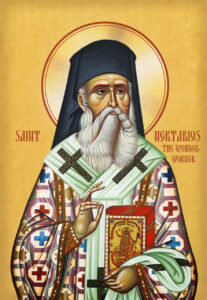
People see St. Nektarios often. Even without knowing him yet, without praying to him, without asking for anything, they receive the requested help by his prayers—there are many such testimonies. Not long ago, two of our workers witnessed some pilgrims go into the saint’s cell, including a woman who had come from Africa with her son. She came to Greece to visit her son who is studying in Thessaloniki, and they came here to Aegina together. As soon as she stepped in, she came to a dead stop—not in a stupor, that is, you could see that she was all there, but she was motionless. One of the sisters ran to Sister Mariam to ask for some holy water to help her. She returned, and the woman started moving and talking a little bit. Her son translated for her: She came to Greece, leaving her 16-year-old child with severe brain cancer at home in Africa—there was almost no hope. As soon as she entered the cell, the side door opened, and, as she recounted, an elder in green vestments stepped out. She couldn’t have known that we preserve his green vestments here—it was her first time in Aegina, and besides, she hadn’t heard anything about the saint. He told her: “Fear not, everything will be fine with your son.” Later, she called us from Africa to tell us that she had returned to find her son completely healthy.
2 This account is from the Blog of Saint Elisabeth’s Convent, Minsk, Belarus, May 4 2021 (catalog-obitel-minsk.com). Apparently similar events have taken place elsewhere as well.

The peasants in a mountainous village of Aegina had been without a priest for years. Time was going by, but nothing was changing. Lent came, but they still had no priest. The people were worrying. In the first and final weeks of the Great Lent, most Greeks put their work and daily business on hold to dedicate themselves to prayer. Everywhere, they lower the flags as if in mourning for the crucified Christ. Every day, the people stand long hours at the Lenten services, walk in processions around their parishes, keep a dry fast, and some do not eat at all. Few in the village could imagine spending all this time without a priest.
The peasants wrote a letter to the bishop asking him to send them a priest. “Your Holiness, could you please appoint us a priest, at least for the Bright Week and the Pascha,” they implored. “We need him to lead and guide us in our preparation, prayer and repentance, and in the celebration of the Bright and Holy Pascha. Do not let your flock go without a shepherd, do not let our pleas go unanswered. Your Holiness, please send us a priest of Your choosing.”
The bishop read the letter and conveyed the request of the mountain dwellers to the participants in the next episcopal meeting. “Fathers, who can travel to this village for the Lenten weeks?” he asked. But none of the priests could, and each gave a valid reason. As the meeting continued, the request from the mountain dwellers was lost among the other agenda items and the current documents. Everyone forgot about the letter, busy with the other errands and preparations for the Pascha.
Finally, the Great and Holy Pascha came, which all Greeks celebrate together in great awe and piety. Because Orthodox Christianity is Greece’s official religion, it is also a public holiday upheld at the governmental level. The Pascha week was over, and the episcopate’s priests were back at work. The bishop saw a letter on his table, and again it was from the mountainous village. It read, “Your Holiness, we have no words to convey to you our gratefulness and deep appreciation for your consideration and attention to the needs of our parish. Forever we will praise the Lord and be thankful to you, Your Holiness, for sending us this pious and blessed priest to lead our Paschal celebrations. Never before have we prayed together with a priest of such exceptional grace and humility.”
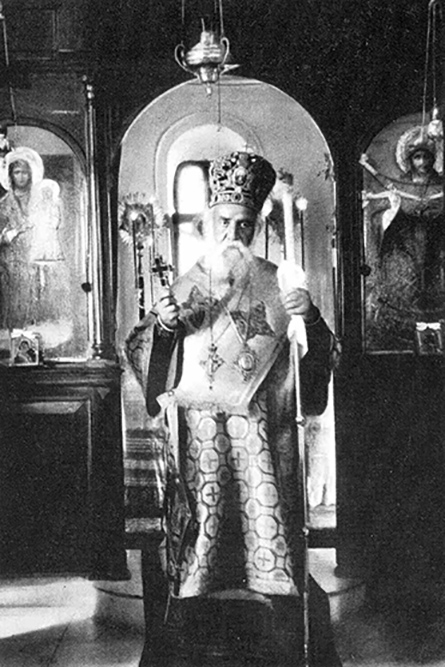
At the next episcopal meeting, the bishop asked the attending priests, “Last time, I read our a letter from the peasants of a mountainous village who requested a priest. Who travelled there?” Everyone was silent, no one said a word. The bishop was intrigued and curious. So he put together a delegation and days later, dust was clouding over the mountainous village on Aegina Island as the bishop and his group approached the village. It was the bishop’s first visit there with such a large group of people. The parishioners met him with paschal cakes, festive drinks, painted eggs and bunches of flowers. In a solemn procession, they all went to the small church.
In Greece, all priests are civil servants, and they are required to enter their names in a designated logbook of the church, even if they serve there only once. The bishop bowed before the icon of the church’s patron saint and went into the altar. The Royal Doors were open, and all the people at church saw him pick up the logbook and take it to the nearby narrow window. Hastily, he paged through it and found the last entry. The inscription, made in elegant handwriting and beautiful ink, read, “Nectarios, Metropolitan of Pentapolis.”
Lest we run out of space, I’ll make you dig for the next four.
3 The raising from death of boy who had been killed: https://www.imoph.org/Theology_en/E3d5018AgNektariosThayma.pdf
4 Healing of a dying priest in Greece from Mystagogy, The Weblog of John Sanidopoulos, (http://www.johnsanidopoulos.com/2009/06/miracle-of-saint-nektarios-healing-of.html)
5 Healing of a crippled man: from Mystagogy: The Weblog of John Sanidopoulos, (http://www.johnsanidopoulos.com/2009/06/miracle-of-saint-nektarios-healing-of.html)
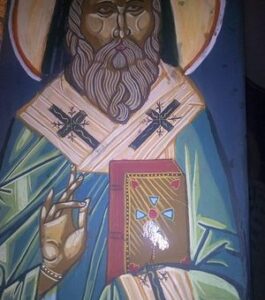
6 A Myrrh-streaming icon of Saint Nektarios in Nairobi, Kenya, November, 2018: https://www.pravmir.com/icon-of-st-nektarios-streams-myrrh-on-his-feast-day-archbishop-of-nairobi-reports/
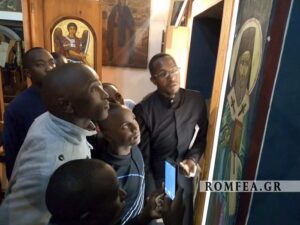
7 Healing of a tetraplegic by Saint Nektarios: https://www.stnektariosmonastery.org/saint-nektarios/Healing%20of%20a%20Tetraplegic%20by%20St.%20Nektarios.pdf
Search online and you’ll find many more of Saint Nektarios’ miracles.
To access much more about Saint Nektarios, go to Orthodox Wiki: https://orthodoxwiki.org/Nectarios_of_Pentapolis
My Own Experiences with Saint Nektarios
Of course the movie didn’t tell you about this.
I know you long-time readers have heard these stories at least three times before. Well, you’re about to hear them again! partly for the edification of newer folks, but mostly because I just love to tell about Saint Nektarios. Humor me.
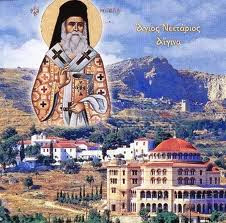
In the year 2000, I think it was, our parishioners Tony and Chrys Wood returned from Greece, and Tony (+ memory eternal) brought me a copy of the book Saint Nektarios: The Saint of our Century, and told me what a wonderful place Saint Nektarios’ monastery was. He said he couldn’t get it into words. I read the book, and when I came to the part where the miracles began I got the holy chills and knew I had to go there.
Thank God that by this time we had the money, and my parish council was very generous with time off. Thus began a series of strange, sometimes funny, “coincidences” on successive trips to Greece – all directly involving Saint Nektarios.
So in 2002, after leaving Mount Athos and then recovering from a bad cold, I had one short day to get to Piraeus, the port of Athens, ferry out to Aegina, visit Nektarios’ monastery (properly “Trinity Monastery”), get back to Athens, return to the hotel in the central city for my luggage, and make it back to Piraeus, because I had ferryboat reservations overnight to Crete.
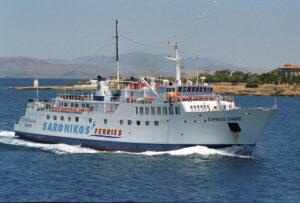
Only when I got to Piraeus did it occur to me that I had no idea how to get to Saint Nektarios’ monastery when I got to Aegina. Why? I don’t know. I’m usually very careful about these things.
Then I missed the 9 o’clock boat, and the 10 o’clock was cancelled. I sat there on the dock feeling disconsolate and, without planning it, heard myself saying “Saint Nektarios, I want to visit you. Help.”
And I guess he did. Then followed a series of “coincidences”: Note: I was not dressed in clerics, so that didn’t get me any special treatment. On the boat I met a young Russian monk who got me a free ride to the monastery and a guided tour through it. Then some Canadian people paid my way back to Aegina port, where an ice cream shop provided me with a double chocolate sundae (my favorite, though I didn’t even know what’s what I had ordered!), and I got back to Athens with about four hours to spare. As the day went on, all this seemed less and less like coincidences and more like someone was behind it. After all I had asked him for help. For many days after I kept smiling and saying “Thank you, Saint Nektarios”..
You know I go to Greece because I love the place, but also every time I just felt compelled to visit Saint Nektarios again.
These next two incidents only left me pondering:
In 2004 a series of very unlikely metro and ferry connections got me to Aegina two hours early.
In 2005 the taxi got me back to the hotel just minutes before a cloudburst; the flooded streets would have stranded me at the port.
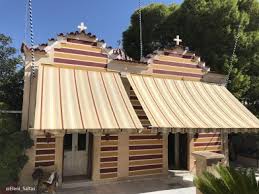 This incident was remarkable: In 2006 as I sat on the bench outside Saint Nektarios chapels, suddenly there beside me sat a couple I had known well in Wisconsin 25 years before when we were Episcopalians. Now they were Orthodox, too! That seemed too “coincidental” to be a coincidence.
This incident was remarkable: In 2006 as I sat on the bench outside Saint Nektarios chapels, suddenly there beside me sat a couple I had known well in Wisconsin 25 years before when we were Episcopalians. Now they were Orthodox, too! That seemed too “coincidental” to be a coincidence.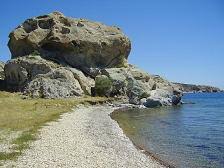
In 2007 on Patmos I went to an isolated beach (to study Saint John’s Revelation, believe it or not) with necessities carefully packed, each in its proper bag. I climbed back up to the car, and the car key was not in the bag! I searched everything three times. No key. Out of my mouth came an unplanned unmannerly “Nektarios! Help!” I reached into the bag and the key was right on top. I suppose I could have missed it three times, but…
In 2008 our luggage vanished as we changed planes in Montreal. By now I was catching on and, after panicking for a while, calmly said, “Saint Nektarios, help”. Our luggage arrived fifteen minutes before our plane left for Greece.
Later that trip on Crete I forgot to buy petrol before I 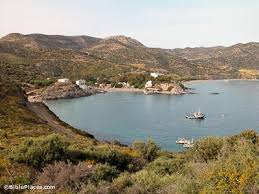 drove to Kali Limenes (“Fair Havens” in Acts) where Saint Paul’s ship stayed for a while – an isolated place about 25 miles from a gas station. I looked and the gauge showed about 1/16 full. I had no idea what to do, so this time I automatically said “Saint Nektarios, help me!”, explored for a while, then took a book to the beach and tried to stay calm. When I came back the tank was well over 1/3 full!
drove to Kali Limenes (“Fair Havens” in Acts) where Saint Paul’s ship stayed for a while – an isolated place about 25 miles from a gas station. I looked and the gauge showed about 1/16 full. I had no idea what to do, so this time I automatically said “Saint Nektarios, help me!”, explored for a while, then took a book to the beach and tried to stay calm. When I came back the tank was well over 1/3 full!
All coincidences? Well, I couldn’t prove otherwise. But really, after that many “coincidences”, it’s fairly obvious it was more than coincidence. That is only good scientific reasoning.
Now, Saint Nektarios is not known for doing “cutesy” tricks! (These don’t rise to the level of miracles.) So why had he done so many for me? Surely not to entertain me. Looking back, I think it was because I’m shallow. There was no other way to catch my attention.
So in 2009 I said to him, “OK, I know you’re there! so please, no more tricks this time.” By then I wastalking to dear Nektarios and asking his prayers daily, and I was building up devotion to him in my parish. We had his icon on the wall of the church, with candles beneath it. I figured that had been his purpose.
As I had requested, nothing unusual happened that year or for several succeeding years.
In 2014, I believe it was, the “miracle” was to have Khouria Dianna there with me for the first time.
However, I now believe Saint Nektarios had a deeper purpose all along. In the year 2015 Dianna suddenly had major aggressive cancer. Her oncologist was competent and hopeful, but of course we were terribly frightened. We had many people praying for her. We prayed to our Lord Jesus, of course. But also, without having to think twice about it, I knew exactly who else to turn to: Saint Nektarios. I bombarded him. I prayed his Paraklisis every day.
Today, seven years later, even now as I sit here writing, Dianna is sitting across the living room from me, healthy as can be. I truly believe this is what all my experiences with Saint Nektarios led up to.
In 2016 the two of us visited Saint Nektarios together again, both of us in gratitude. And next Wednesday November 9 we will go together to Divine Liturgy on the feast of Saint Nektarios, the Wonderworker of Aegina.
This is the hymn to the Theotokos written by Saint Nektarios, sung by Eikona. (The English begins at the second verse.)
Next Week: The Advent Fast (already?)
Week after Next: Bishops who resisted Civil Authority and… well, you may try to guess where I’m going with this one